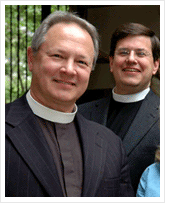Clergy
 Religion is very important to millions of Americans. Most religious groups are led by a member of the clergy, also known as a cleric. As a result, clerics counsel and assist people during important life events, such as the birth of children, marriage, personal crisis, and death. Although clerics are usually identified with delivering sermons, they spend the majority of their time away from the pulpit, and some clerics do not lead congregations. Some clerics serve as military chaplains or attend to the spiritual needs of people in prison or hospitals. Clerics often spend their nights and weekends officiating at official events or attending to the needs of members of their congregation. Successful clerics are inspiring pubic speakers, but more importantly, effective clerics have the ability to motivate people during crises. During economic recessions, more people will experience adversity. Clerics are not required to have unquestioning religious faith; clerics, just as other religious people, can experience doubt.
Religion is very important to millions of Americans. Most religious groups are led by a member of the clergy, also known as a cleric. As a result, clerics counsel and assist people during important life events, such as the birth of children, marriage, personal crisis, and death. Although clerics are usually identified with delivering sermons, they spend the majority of their time away from the pulpit, and some clerics do not lead congregations. Some clerics serve as military chaplains or attend to the spiritual needs of people in prison or hospitals. Clerics often spend their nights and weekends officiating at official events or attending to the needs of members of their congregation. Successful clerics are inspiring pubic speakers, but more importantly, effective clerics have the ability to motivate people during crises. During economic recessions, more people will experience adversity. Clerics are not required to have unquestioning religious faith; clerics, just as other religious people, can experience doubt.
Clergy include ministers, pastors, priests, bishops, imams and rabbis. Some priests or rabbis are scholars or teachers. Some ministers become missionaries and offer religious and social assistance to people throughout the world. Chaplains provide spiritual guidance in hospitals, the armed services and schools.
Typical Job Responsibilities
- Organize and lead religious services
- Instruct people that seek conversion to a particular faith
- Read from sacred text to their congregation
- Provide counseling to groups and individuals regarding their spiritual, personal and emotional needs
- Train leaders of church, community and youth groups
- Visit people in hospitals, homes and other settings to provide comfort and support
- Administer religious ordnances or rites
Clergy sometimes work 10 to 12 hours a day. They typically work on weekdays as well as weekends. They often work part of the week performing their administrative tasks and preparing for religious services. Clergy members also dedicate quite a bit of time helping those that are troubled, sick or need spiritual guidance.
Employment Outlook
Employment growth for clergy from 2008 to 2018 is projected to be about as fast as average for all occupations. In 2008 the median annual earnings for clergy was $41,730. Those clergy who are skilled public speakers may earn more than the average.
Edcation and Training
Requirements to become a member of the clergy depend on the religious organization. According to the Department of Labor, most religious organizations require potential candidates to receive graduate training while some will choose people who have been �called� to the clergy. Interested individuals should speak to a representative of the organization they would like to serve in, to find out how to become a cleric.
Median (8 year of experience): $44,900
25-75 percentile (8 years or more of experience): $39,500-71,100
Major Employers
The top employers are religious organizations, hospitals, home health care services, state government and nursing care facilities.
Industries with the highest levels of employment in this occupation:
| Industry |
Employment |
Hourly mean wage |
Annual mean wage |
| RELIGIOUS ORGANIZATIONS |
23,260 |
$22.38 |
$46,550 |
| MEDICAL AND SURGICAL HOSPITALS |
6,020 |
$22.45 |
$46,690 |
| HOME HEALTH CARE SERVICES |
4,040 |
$22.36 |
$46,510 |
| NURSING CARE FACILITIES |
1,650 |
$20.13 |
$41,860 |
| STATE GOVERNMENT (OES Designation) |
1,510 |
$25.03 |
$52,060 |
|
 |
|
Career Education Finder
|
|
Get information on career education programs that could help you increase your earning power.
|
|